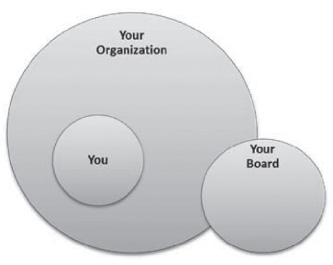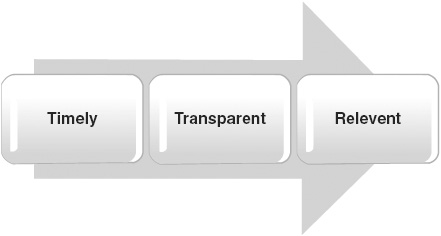
Three people were at work on a construction site. All were doing the same job, but when each was asked what the job was, the answers varied. “Breaking rocks,” the first replied. “Earning my living,” the second said. “Helping to build a cathedral,” said the third.
– Peter Schultz
We all see things from our own point of view. Boards, however, often seem to have more than one perspective from which to interpret the world.
If you think about it, your board is really a hybrid of your internal and external communities; although when it comes to having their “say” on organizational matters, they are firmly entrenched (at least in their minds) insiders. Perhaps you see them differently. The following diagram provides a visual illustration of where the interfaces are and where the pressures on the relationship originate. Notice that pressures on the relationships can originate from either inside or outside the organization.
The fragility of the relationship between board and management can stem from the simple truth that you are on the inside every day, and they are not. Therein rests both their strength and their weakness.
Being on the outside looking in provides an oft-needed objective eye. When you are so close that you can’t see the forest for the trees, it can help to have strong rapport with a group one step removed. Further, this external view provides important input that may reflect where their other foot is planted – namely, the external community. That external input coming from a group that has a vested interest in what you are doing is valuable.
Figure 8.1 Your Organization/Your Board/Your Community

On the other hand, as many healthcare managers have learned from hard experience, boards sometimes can’t quite grasp the rhyme and reason of what are now the realities of today’s healthcare industry. In health care, perhaps more than in any other industry, self-identification can cloud the reasoning of even the most level-headed board member. The emotion and value-laden characteristics of health care sometimes make that highly regarded objectivity a fleeting commodity.
Therefore, the relationship between administration and board, fuelled as it is by communication processes, can be a challenging one. However, being strategic about communication with your board can go a long way toward building a mutually beneficial relationship and your own credibility.
If you are a front-line or middle manager, your direct communication with your healthcare institution’s board may be almost nil. That does not mean that you should ignore the nuances of how the channels of communication shape decisions that will ultimately affect you both as an employee and as a manager.
“Most affairs of American life are controlled or influenced by boards.”1 This is the opening line in Cyril O. Houle’s book Governing Boards, and a scary one at that. Houle goes on to give us chapter and verse about the kinds of groups who sit around “boardrooms” (they are everywhere, aren’t they?) and make decisions that affect our lives. He lists churches; governments; private corporations; educational institutions; professional organizations; trade unions; not-for-profits; and, of course, healthcare organizations, to name a few.
Could your organization accomplish its goals without a board? Think very carefully about your answer. Your positive or negative response is likely to be directly correlated to the quality of your own personal relationship with your board, or the preconceived notions you hold if you are currently at a level in the hierarchy where you do not yet have any direct interaction with your board. Whether you believe that they are effective or not, they do have a degree of power that is a reflection of the trust (hence the term trustees) that your community has in your board’s role in protecting their interests. A wise administrator respects that public trust and recognizes the image power that a board has. This alone makes strategic communication with your board vital – not for the purpose of controlling them, but for developing a rapport with them.
It may seem self-evident why high-level managers and executives need to communicate with their boards. But if you consider this just another part of your managerial duties when you are at that level, you have missed the point of recognizing the importance of strategic communication. There should never be an encounter between you or your managers and your board that is not purposeful and well considered.
The first strategic purpose of communication with your board is a result of their view of themselves as insiders. They have informational needs. Thus, your goal is to inform. What you inform them about, to what extent, and when are strategic considerations.
Board members need information about
• background on issues that they will consider as part of their role as board members,
• actions taken by administration that are likely to be made known publicly,
• any new or unusual occurrences that are being made public through the media whether traditional or new media.
Essentially, your board members need enough information to do their jobs and to feel that they are important insiders. In addition to this, because they are important external ambassadors of your organization, they need to be “kept in the loop” about issues that are or will be of a public nature. There is nothing more irritating for a board member than to hear about an organization’s activities in the news or from a neighbour. If you want to incite them to riot, just treat them with less consideration than you do your employees.
Obviously, your opinion about how much information they need to do their jobs may differ from their opinions about how much information they need. In addition, there are likely to be differing perspectives on this issue from one board member to another. This is why a good personal relationship with the board chair can be helpful for health-care managers at the top of the organizational hierarchy. Your own interpersonal skills are called into play in the development of your relationship.
A good board chair who understands administration’s point of view (although he or she might not always agree with it) can be a formidable ally in your quest to woo your board. Cultivating this interpersonal relationship can be a key element in your ability to communicate your messages effectively to them.
The second important purpose for communication with your board is to persuade them about issues for which, from your perspective at least, you need their support. One of the most important aspects of persuasion when dealing with your board is to ensure that you tailor your message specifically to this audience. It will not be effective enough to simply use the same approach that you use for this issue with clients and the community, or even your employees for that matter. You need to think very carefully about packaging the persuasive message for your board. This may mean thinking about each individual’s perspective as you prepare for any presentation of a persuasive nature.
Just as important as purpose and message when communicating with your board, so too are when and how you do it.
The first rule of when to communicate with your board is to do it regularly. And this does not mean only at scheduled board meetings. You need a vehicle for direct communication between the highest levels of administration in your organization and all board members between board meetings. If your organization is of any size at all, you need to put this in writing.
As the CEO, you’ll need to develop a communication vehicle whose objectives are to
• nurture your relationship with each board member,
• inform them of information in a timely fashion, and
• cultivate within them a feeling of belonging to your organization.
From these objectives come the content and the vehicle for sharing the information. Consider each of these objectives to ensure that any material you send achieves each one, every time. Following are some suggestions for the kind of materials that would help to move you toward your goals:
• a monthly message from the CEO and/or other managers: the vehicle you choose depends on your board whose media preferences should be well known to you,
• an intranet that is updated regularly,
• a media monitor with explanatory notes as necessary,
• a calendar of internal events as well as external events that your organization may be participating in.
There was a time when debates on the efficacy of electronic distribution raged. In general, those debates are over: electronic distribution is expected and usually preferred by most people these days. That being said, there may be reasons to include print publications in your communication repertoire. Knowing your board members and their preferences can help to guide your decision on the most appropriate vehicles for informational and persuasive communication approaches.
Board – administration communication can often be a special challenge for healthcare managers. If you share a vision and a set of core values, however, communication will at least have a common ground from which to start. After that it is up to you.
Your personal skills in communication are essential to both you and your organization.
As one blogger2 suggests, make your board communication timely, transparent, and relevant.
Figure 8.2 Characteristics of Effective Board Communication

Joshi, Maulik, and Bernard Horak. Healthcare Transformation: A Guide for the Hospital Board Member. Boca Raton, FL: Taylor & Francis, 2009.
“Five Ways to Improve Internal Communications at Your Non-profit.” https://charityvillage.com/Content.aspx?topic=five_ways_to_improve_internal_communications_at_your_nonprofit
“7 Strategies for More Productive Non-Profit Board Meetings.” http://www.thefundraisingauthority.com/strategy-and-planning/more-productiveboard-meetings/